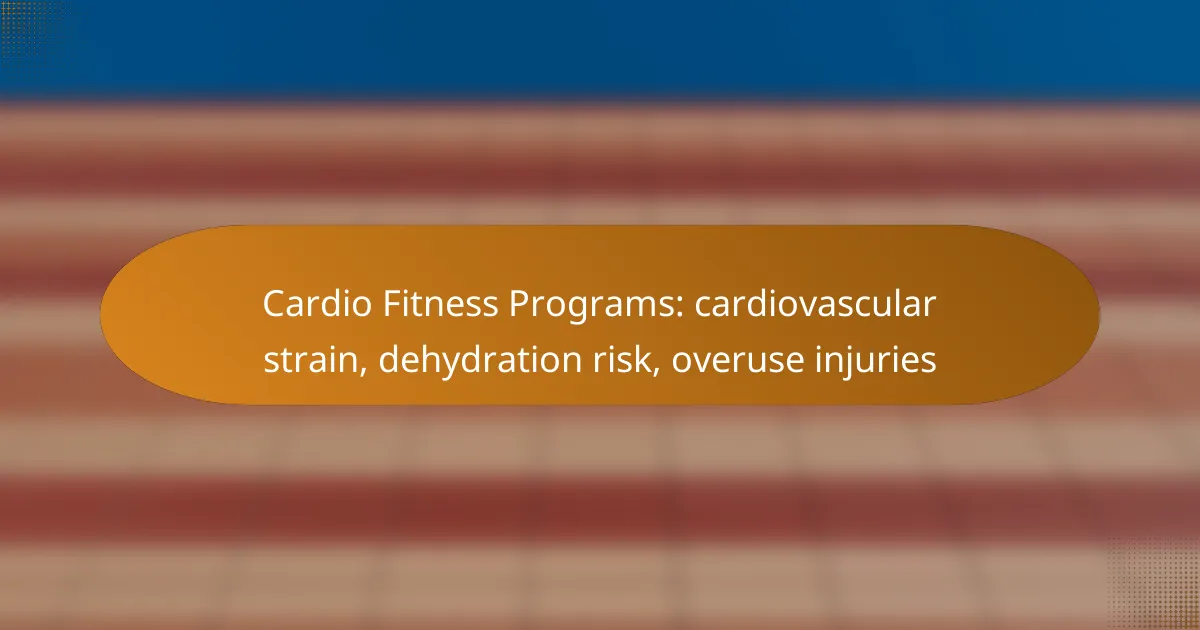Cardio fitness programs are essential for improving cardiovascular health, but they must be carefully designed to manage cardiovascular strain and prevent injuries. Proper hydration practices are crucial to mitigate dehydration risks during intense workouts, while attention to training techniques can help avoid common overuse injuries. Tailoring these programs to individual needs ensures both safety and effectiveness in achieving fitness goals.

What are effective cardio fitness programs for cardiovascular strain?
Effective cardio fitness programs for managing cardiovascular strain include a variety of structured workouts that emphasize intensity, duration, and recovery. These programs should be tailored to individual fitness levels and health conditions to minimize risks while maximizing benefits.
High-Intensity Interval Training (HIIT)
HIIT involves short bursts of intense exercise followed by brief recovery periods. This method can significantly improve cardiovascular fitness in a shorter time compared to traditional steady-state workouts. However, it is crucial to ensure proper form and adequate recovery to avoid overexertion.
When starting with HIIT, aim for sessions lasting 20-30 minutes, incorporating intervals of 20-60 seconds of high effort followed by equal or longer rest periods. Beginners should gradually increase intensity and duration to prevent injury.
Low-Impact Aerobics
Low-impact aerobics provide a gentler approach to cardiovascular fitness, making them suitable for individuals with joint concerns or those new to exercise. These workouts typically include movements that keep one foot on the ground, reducing the risk of strain.
Classes often last around 45-60 minutes and can include activities like step aerobics or dance-based routines. Focus on maintaining a steady pace and listen to your body to avoid fatigue or discomfort.
Running Programs
Running programs can effectively enhance cardiovascular endurance but require careful planning to avoid overuse injuries. Gradually increasing mileage and incorporating rest days are essential to allow the body to adapt and recover.
Consider following a structured plan, such as the Couch to 5K program, which typically spans several weeks and builds up from walking to running. Pay attention to proper footwear and running surfaces to minimize strain on joints.
Cycling Classes
Cycling classes, whether on stationary bikes or outdoors, provide a low-impact option for improving cardiovascular health. These classes often feature varied intensity levels, allowing participants to adjust their effort according to their fitness levels.
Sessions usually last 45-60 minutes and can include intervals, climbs, and sprints. Ensure you are properly fitted to your bike to avoid discomfort and reduce the risk of injury during workouts.
Swimming Workouts
Swimming workouts are an excellent choice for cardiovascular fitness, offering a full-body workout with minimal impact on joints. The buoyancy of water reduces strain, making it ideal for individuals recovering from injuries or those with chronic pain.
Sessions can vary in length but typically last 30-60 minutes, incorporating different strokes and drills. Focus on maintaining a steady pace and consider joining a swim class for structured guidance and motivation.

How can dehydration risk be managed in cardio fitness?
Dehydration risk in cardio fitness can be effectively managed through proper hydration practices, monitoring fluid intake, and understanding individual needs based on activity intensity and duration. Staying hydrated helps maintain performance and reduces the likelihood of heat-related illnesses.
Hydration Guidelines
To prevent dehydration during cardio workouts, aim to drink fluids before, during, and after exercise. A general guideline is to consume about 500-600 ml of water two to three hours before exercising and 200-300 ml every 10-20 minutes during the activity. Adjust these amounts based on temperature, humidity, and personal sweat rates.
Monitoring urine color can also provide insight into hydration status; pale yellow typically indicates adequate hydration, while dark yellow suggests a need for more fluids.
Electrolyte Supplements
In addition to water, electrolyte supplements can be beneficial during prolonged or intense cardio sessions, especially in hot conditions. These supplements help replenish essential minerals lost through sweat, such as sodium, potassium, and magnesium. Consider using sports drinks or electrolyte tablets that contain these minerals.
For workouts lasting longer than an hour, aim for a drink that provides around 500-700 mg of sodium per liter to effectively replace lost electrolytes.
Pre-Workout Hydration Strategies
Before starting a cardio workout, establish a hydration routine that includes drinking water or an electrolyte beverage. Consuming a small amount of fluid 20-30 minutes prior to exercise can enhance hydration levels. Avoid excessive intake right before starting, as it may lead to discomfort during the workout.
Additionally, consider the temperature and humidity of your workout environment; in hotter climates, increase your fluid intake to compensate for higher sweat loss. Keep a water bottle handy to encourage regular sipping throughout your session.

What are common overuse injuries in cardio fitness?
Common overuse injuries in cardio fitness include conditions that arise from repetitive stress on muscles and joints, often due to excessive training or improper technique. These injuries can lead to pain and discomfort, impacting performance and overall fitness.
Shin Splints
Shin splints, or medial tibial stress syndrome, occur when the muscles and tendons around the shinbone become inflamed. This condition is often caused by high-impact activities like running on hard surfaces or sudden increases in training intensity.
To prevent shin splints, gradually increase workout intensity and incorporate rest days. Stretching and strengthening exercises for the lower legs can also help reduce the risk.
Runner’s Knee
Runner’s knee, or patellofemoral pain syndrome, is characterized by pain around the kneecap, particularly during activities like running or climbing stairs. It typically results from muscle imbalances, overuse, or improper footwear.
To mitigate runner’s knee, ensure proper footwear and consider cross-training to balance muscle development. Strengthening the quadriceps and hip muscles can also provide support to the knee joint.
Plantar Fasciitis
Plantar fasciitis involves inflammation of the plantar fascia, the tissue connecting the heel to the toes, leading to heel pain. This condition is common among runners and can be exacerbated by inadequate footwear or excessive mileage.
To prevent plantar fasciitis, choose supportive shoes and avoid running on hard surfaces. Stretching the calf muscles and using orthotics can also alleviate strain on the plantar fascia.

What criteria should be considered when choosing a cardio fitness program?
When selecting a cardio fitness program, consider your current fitness level, the duration of the program, and the qualifications of the instructor. These factors can significantly impact your experience and results, ensuring that the program aligns with your personal health goals and capabilities.
Fitness Level Assessment
Assessing your fitness level is crucial before starting any cardio program. This evaluation helps determine the intensity and type of exercises suitable for you, minimizing the risk of injury and ensuring effective workouts. Consider using a simple self-assessment or consulting a fitness professional for a more accurate evaluation.
Common indicators of fitness level include your ability to sustain aerobic activity, your heart rate response to exercise, and your recovery time after workouts. For example, beginners may start with low-intensity sessions, while more experienced individuals can handle higher intensity or longer durations.
Program Duration
The duration of a cardio fitness program can vary widely, typically ranging from a few weeks to several months. Shorter programs may focus on specific goals, such as improving endurance or weight loss, while longer programs often incorporate progressive training techniques to enhance overall fitness.
When choosing a program duration, consider your personal schedule and commitment level. Programs that last 4 to 12 weeks are common, allowing sufficient time for adaptation while keeping you motivated. Ensure that the program includes rest days to prevent overtraining and promote recovery.
Instructor Qualifications
The qualifications of the instructor play a vital role in the effectiveness of a cardio fitness program. Look for instructors with certifications from recognized organizations, as this indicates a level of expertise in fitness training and safety protocols. Certifications from bodies like ACE, NASM, or ACSM are widely respected.
Additionally, consider the instructor’s experience and teaching style. An effective instructor should be able to tailor workouts to various fitness levels and provide modifications as needed. Engaging with an instructor who communicates well and motivates participants can enhance your overall experience and results.

How to prevent cardiovascular strain during workouts?
To prevent cardiovascular strain during workouts, focus on proper preparation, monitoring, and gradual progression. These strategies help maintain a safe exercise intensity, reducing the risk of overexertion and related injuries.
Proper Warm-Up Techniques
Effective warm-up techniques prepare your body for physical activity and help prevent cardiovascular strain. Start with 5-10 minutes of low-intensity activities like brisk walking or light jogging to gradually increase your heart rate.
Incorporate dynamic stretches that target major muscle groups, such as leg swings and arm circles. This increases blood flow and flexibility, making your workout safer and more effective.
Monitoring Heart Rate
Monitoring your heart rate during workouts is crucial for preventing cardiovascular strain. Aim to keep your heart rate within a target zone, typically 50-85% of your maximum heart rate, which can be roughly estimated by subtracting your age from 220.
Use a heart rate monitor or fitness tracker to stay informed about your intensity levels. If your heart rate exceeds the target zone, consider slowing down or taking a break to avoid overexertion.
Gradual Intensity Increase
Gradually increasing workout intensity is essential for minimizing cardiovascular strain. Avoid jumping into high-intensity workouts; instead, increase your exercise intensity by no more than 10% per week.
This approach allows your cardiovascular system to adapt safely. Listen to your body and adjust your workouts based on how you feel, ensuring you don’t push yourself too hard too quickly.



